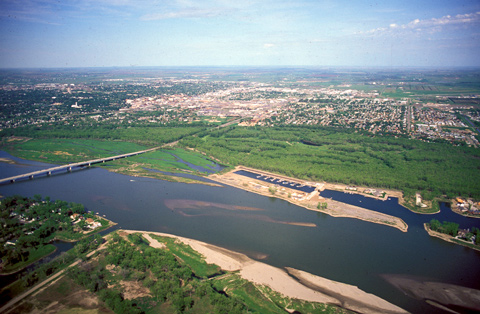The Corps of Discovery arrived in the vicinity of this picture on 20 October 1804, having worked their way some 1,450 miles up the Missouri in 155 days. They camped on the west side of the river, probably several miles downstream, to the right of this view.
That day, wildlife was the main attraction hereabouts. They had recently seen signs of the dreaded grizzly bear, or “White bear,” and that day Clark saw “Several fresh track of those animals which is 3 times as large as a mans track.” He also saw “great numbers of buffalow Swimming the river.” Lewis’s short entry for the day recounted the misadventures of Pierre Cruzatte, who ran afoul of one of each. He wounded a bear, whose “formidable appearance” prompted him to drop his tomahawk and gun and run for it, to find upon returning to retrieve his weapons that the bear had run the opposite direction. Then he took a shot at a buffalo cow, breaking one of her legs. When she threateningly ran in his direction he ducked for cover in a small ravine.
The buffalo had long been on the road toward extinction by the time the Northern Pacific Railroad was completed in 1882, and the surviving grizzlies were retreating toward the Rockies. Today there are bison at Bismarck’s Dakota Zoo, but no grizzlies.
Returning on 18 August 1806, after bucking headwinds and high waves all day, the Corps camped for the night on the far side of the river, across from today’s Bismarck, North Dakota. Now accompanying them was the Mandan chief Sheheke and his family, who had joined the homeward-bound expedition during its stop at their village. The chief had agreed to go with the captains to meet President Jefferson. In Washington, Sheheke indeed met Jefferson and was lavishly feted, then proceeded to Philadelphia where the well-known artist, Charles B. J. F. de Saint Mémin, painted portraits of him and his wife, Yellow Corn. Sheheke was to return home in 1807, but interference from the Sioux and Arikara delayed him and Yellow Corn two more years.
From Discovering Lewis & Clark from the Air
Photography by Jim Wark
Text by Joseph Mussulman
Reproduced by permission of Mountain Press

